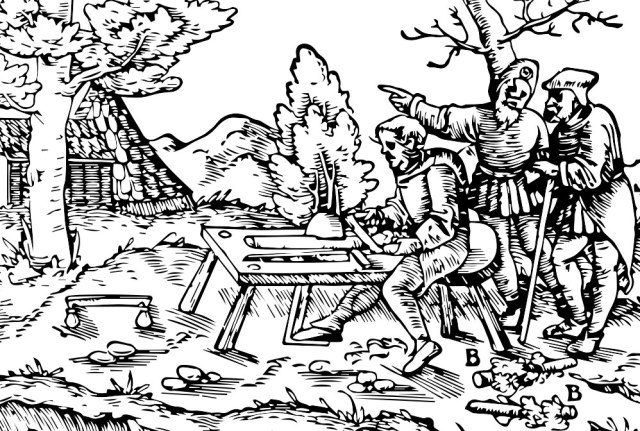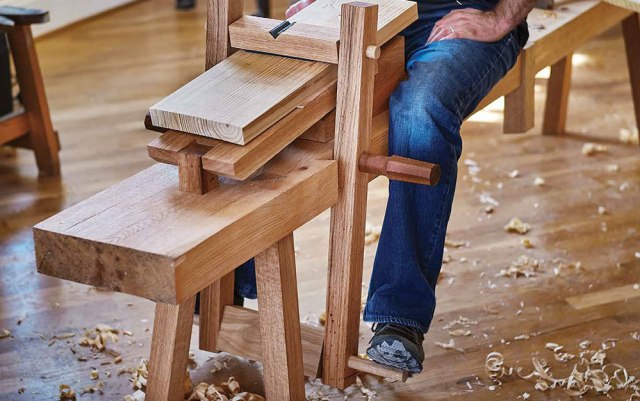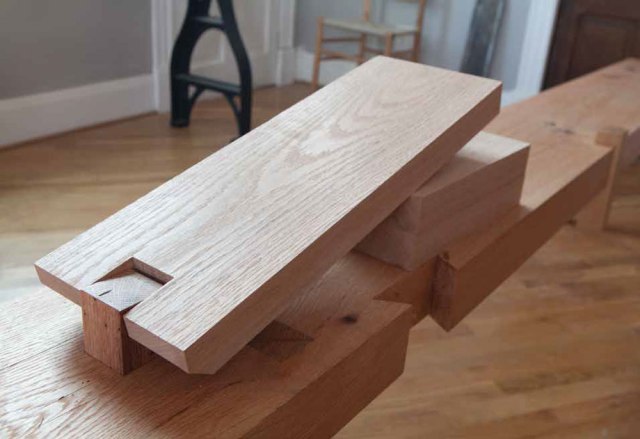
This is an excerpt from “Ingenious Mechanicks” by Christopher Schwarz.
Many visitors to my shop are intrigued by the low Roman-style workbenches (especially the children, who play Whac-A-Mole with the pegs). The most frequent questions I hear are: Were the Romans Lilliputians? And is this low workbench where the shaving horse came from?
It’s impossible to know for sure. But it is a short intellectual hop from a workbench you sit on to a shaving horse. And because there are so many variants to the Roman-style bench – for shipbuilding, steam bending, wagon building and on and on – the shaving horse might just be one of the many flavors of the low bench that developed for the specialty trades.
A small breadcrumb of evidence is the 1561 woodcut in book five of “De Re Metallica” (“On the Nature of Metals”) by Georgius Agricola. In the image, a German woodworker is shown shaving a stick to a fan shape so it can be used in a mine. Miners would use these dry sticks to help dislodge the ore they were seeking. The fan shape made the sticks easy to light on fire.
The first time I saw this woodcut, my brain saw a low Roman workbench instead of a shaving horse. Perhaps you can see the same thing I did – perhaps not. In any case, this image inspired me to add a removable shaving horse to one of my low benches.
The type of shavehorse shown in “De Re Metallica” is called a “dumbhead” or “Continental” style. These shavehorses have the pivoting clamp in the center of the bench and you squeeze your work either to the left or right of the clamp. The variation I built is commonly called an English shaving horse, which appears much later in the visual record.

Instead of a central pivot, the English shavehorse has two arms on the outside of the bench.
I’ve used both styles (including the mutant Shave Pony), and I decline to participate in the Shavehorse Holy Wars. I chose the English style because it is the style I have used the most and it was the easiest to adapt to an existing low workbench. All credit is due to Jennie Alexander for introducing me to this style of horse through her writing.
Here’s how it works: It starts with a 2″ x 2″ x 8″ post that is friction fit into the mortise that also holds the workbench’s planing stop. That post is joined to the “stage” of the shavehorse (the work surface of the horse). The two pieces are joined with a 5/8″-diameter dowel, which allows the stage to pivot up and down – just like the leaf of a hinge.

Below the stage is a large wedge-shaped assembly, called the “chock” by Alexander, that looks a bit like an odd drawer. This assembly is not attached to either the stage or the workbench. Moving it forward and back moves the stage up and down so you can clamp workpieces both small and large.
The clamping action is controlled by the arms. The arms pivot on pegs, which are inserted into holes in the edge of the benchtop. Between the two arms are the foot pedal and the head of the shaving horse. You press the pedal at the floor, and the head (sometimes called the “yoke”) clamps the work to the stage.
This horse can hold both short spindles and long legs. While it looks like long workpieces might hit the benchtop, you can simply knock the 2″ x 2″ post up an inch or so, and the work will clear the benchtop.
— Meghan B.